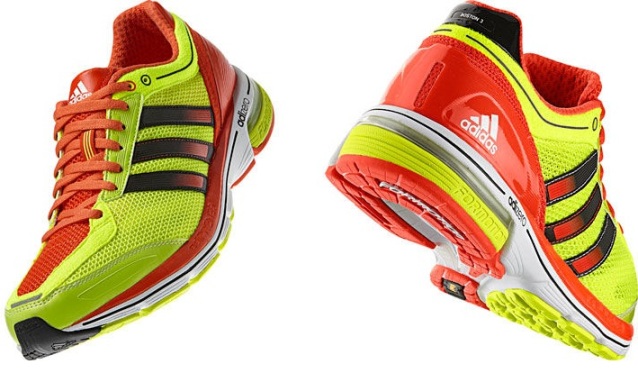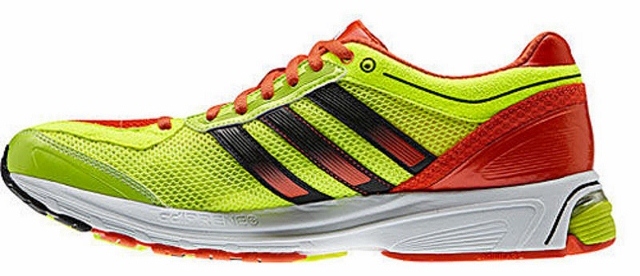The adiZero Boston 3 is named after the world’s greatest marathon, so I had high hopes for this trainer. And it didn’t disappoint.

I’ve been a long-time wearer of the Adidas adiZero line but never wore a pair of the Boston trainers until recently. Billed as a performance neutral shoe at 9.3 ounces, they’re on the heavier end of the minimalist spectrum but balance cushion and groundfeel quite well.
Adidas says of the shoe:
Pull on the men’s adiZero Boston 3 shoes by adidas and you’ll already be well on your way to qualifying.
No shoe is going to get you to the Boston Marathon but these are up to the task of handling your BQ mileage quite well. As long as you can stand the neon colors of course.
Why You Should Vary Your Running Shoes
A lot of runners think that I’m a minimalist runner. I do own a pair of Merrell Trail Gloves and Vibram FiveFingers, after all. But the reality is that I don’t even run in these super lightweight, low-profile, minimalist shoes – I wear them to go to the gym, grocery shopping, or a quick walk.
Like I’ve mentioned before, minimalism is a spectrum and you shouldn’t always be stressing your feet the same way every day. My philosophy on footwear is similar to my general training philosophy: variety is crucial.
Every shoe stresses your foot in different ways. Each will slightly alter:
- foot strike
- heel height (heel-toe drop)
- amount of pronation
- arch support (or lack thereof)
- impact forces
Why not rotate 2-3 shoes that subtley change how you run (while still being comfortable) and how your foot impacts the ground? It’s the same as varying the terrain, pace, workouts, and intensity of your workouts.
I’m currently reading Peter Larson’s book Tread Lightly and the section on running injuries is fascinating to me. We all know that most injuries are overuse injuries, but the phrase “repetitive stress” struck a cord with me. Running injuries are the result of too much repetitive stress – so how do we reduce that stress?
Rotating several different shoes is one way to prevent your running from being so monotonous. For that reason, I wear a wide variety of running shoes and some are more minimalist than others.
The Adidas adiZero Boston 3 is my “go-to” trainer and what I use for long runs and about two-thirds of my total mileage. A little bit of minimalism goes a long way so I don’t overdo barefoot running or wearing ultra-light shoes.
This shoe is firmly planted in the middle of the spectrum: at 9.3 ounces, it’s not super light but it’s not as heavy as a more traditional trainer. The heel-toe drop is 11mm according to Runner’s World, which is slightly below average in my experience. For my main trainer I prefer it being lightweight but with a little more cushion than a “barefoot shoe.”
An important feature of the adiZero Boston is that it’s quite firm. I run most of my mileage on dirt trails so this works very well for me (I don’t like a softer shoe on a soft surface). You may like a firm ride but be aware that it’s unlike other shoes on the market like the Saucony Kinvara that offer a more cushioned sole.
Who Should Buy the Adidas adiZero Boston 3?

The adiZero Boston can work very well for runners looking for:
- an introductory minimalist shoe – lighter than average, but with a fairly normal heel-toe drop
- a firm sole (good for racing, workouts, and those who run on softer surfaces)
- a new type of shoe to add to their rotation that provides all of the above
- a blast of neon color so you don’t get hit by a truck when running predawn
Some reviewers claimed the shoe is narrower than average (especially in the toebox) so if you have wider feet it may not work out for you. My feet are about average width and I didn’t experience any discomfort putting hundreds of miles on them.
The shape of every shoe varies, especially between manufacturers, so it can be helpful to experiment with those that fit your foot best. I’m usually most comfortable in Adidas and ASICS but sometimes struggle to find Saucony’s and Nike’s that are comfortable.
The Boston also has a neat feature that runners who live in wet climates may prefer: it has incredible traction. This is great for me since most of my running is on the trails in Washington, DC, though it is not a trail running shoe. Adidas calls the rubber on the outsole “Continental” and says it provides sure-footed grip. Sounds about right to me!
I’ll continue to wear the adiZero Boston’s as long as the weight remains under 9.5 ounces and Adidas doesn’t change the structure of the shoe dramatically. One of my favorite aspects of the shoe is that it’s fairly low-profile. I don’t feel like I’m wearing high heels or big clunkers like the Brooks Beast when I’m out running. If Adidas keeps the low-profile aspect of the shoe then I’ll keep buying them (and secretly hoping for different colors).
There’s nothing I don’t like about this shoe – except perhaps the $110 price tag – but remember they’re not for everyone. If you’re a wide-footed runner who doesn’t want a lightweight shoe (and hates neon), go elsewhere. It’s probably also best for efficient runners with normal to mild over-pronation.
You can buy the AdiZero Boston’s on Amazon for the cheapest price.
For more reviews, check out the Running Shoe Reviews page.
Have you worn the Adidas adiZero Boston 3 for training or a race? What did you think? What shoe do you recommend for an “introduction to minimalism” trainer?